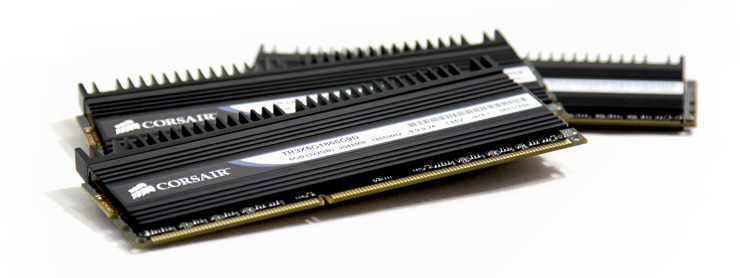A swift 101 on system memory
A swift 101 on system memory
How does RAM memory actually work ?
Adding RAM (random access memory) will normally cause your computer to feel faster on certain types of operations. Some applications (think Photoshop or most movie editing and animation packages) need bags of RAM to do their job. If you run them on a PC with too little RAM you'll see Hard disk swapping / activity constantly brining he system down to a crawl. It as at that tim that you can get a massive speed boost by adding enough RAM to eradicate the swapping. Programs like these can seriously run 10 to 50 times faster once they have enough RAM.
But how does RAM work ? Well, the essence is actually very simple, we live in a digital world with 0's and 1's.To store a 1 in the memory cell, a capacitor is filled with electrons. To store a 0, it is emptied... that's it... it's that simple.
The dilemma with the capacitor's container is that it has a leak. In a matter of a few milliseconds a full bucket becomes empty. Therefore, for memory to work, either the CPU or the memory controller has to come along and recharge all of the capacitors holding a 1 before they discharge. To do this, the memory controller will read the memory and then writes it right back. This refresh operation happens automatically thousands of times per second.
Dual Channel memory ?
Typically you guys make sure that you buy two bars so that you can have a dual-channel memory configuration (color coded identically on your mainboard). Dual channel effectively double's the memory bandwidth and processors loves that bandwidth, for sure, as it can have a nice impact on overall performance.
So keep this in mind: performance and stability of any system depends in part on the memory being used and the settings for the RAM timings. Many users may have their preference for low-quality class-B brands; but certainly using brand name memory is a very good idea since low quality memory is often at the root of many stability issues. However, always pay attention to the timings of the memory being used.
Triple Channel memory ?
With the coming of Core i7 we've seen the integration of on-CPU integrated memory controllers for DDR3 SDRAM with 1 to 3 -- 64-bit memory channels (physically four only three active though). You read it right, a tri-channel memory controller. Therefore total memory bus width goes up from 128 bits to 192 bits allowing a massive bandwidth increase as they are no longer tied to the FSB. Intel eliminated those "FSB brakes" by designing Nehalem's architecture to use 64-bit memory controllers which are connected directly with the processor's silicon. As a result this new design should bring a bandwidth utilization of as much as 90%, a nice jump from today's 50-60% utilization for sure. The new controller of course supports both registered (server market) and unregistered (consumer) memory DIMMs. The controller is fast ... very fast, and supports DDR3-800, DDR3-1066, DDR3-1333 JEDEC standards, yet has room for future scalability. The memory controller is able to handle 64GB/s, a full tri-channel DDR3-1333 implementation will only amount to 32GB/s maximum bandwidth utilization.
Do the math and conclude that even DDR3-2000 will not max out the controller.
So then, three memory channels per processor, each channel supports a maximum of 3 DIMMs. Again do the math and a single processor can support a maximum of 9 memory slots. You are of course free to use one or two DIMMS, but for optimal performance, the minimum would however be three, one DIMM per channel. So depending on the motherboard class of use, the board can come configured with three, six or nine memory slots.
That's what we are looking at today. but not only will we look at the memory in default configuration, no we'll look at the memory at several frequencies and timings.

